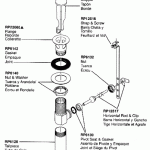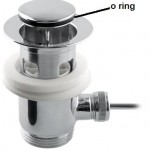Como consertar ou consertar um cano de drenagem da pia da cozinha com vazamento? Mostly leaking comes from the kitchen sink drain assembly where the P-trap connected into the bottom of the kitchen sink. What was perplexing was that there was no apparent leak when I just ran the faucet and let the water drain out the kitchen sink. It turned out that the leak only manifested itself when the sink was first filled with water, and then the drain plug was pulled out of the sink drain.
It was while the large volume of water poured through the drain that I observed water seeping around the large plastic nut that connected the P-trap assembly to the kitchen sink drain itself.
With the source of the leak discovered I removed the P-trap by simply unscrewing the large plastic nut that connected the P-trap to the kitchen sink drain. The P-trap nut can be unscrewed with your hand. No tools were required.
Upon close inspection of the P-trap I noticed that the plastic washer that sat inside the P-trap was deformed and quite dirty.
My first attempt to solve the leak was to clean the P-trap and the plastic washer and then reattach the assembly back to the base of the kitchen sink drain. Unfortunately the leak persisted.
As a result of the failure of my first attempt to fix the leaky kitchen sink drain, I went down to my local home improvement store and picked up a new P-trap and a separate plastic washer.
Once back at my kitchen sink I decided to see if I could save myself some money by just replacing the plastic washer. De novo, I unscrewed the P-trap nut that connected to the bottom of the sink drain. I then swapped out the old plastic washer with the new one and then reattached the plastic P-trap to the base of the kitchen drain sink. I also made sure that the P-trap nut was tightly fastened to the base of the kitchen sink. I then filled the kitchen sink with water and then removed the drain plug. Sure enough, the leaky kitchen sink drain was a thing of the past.






